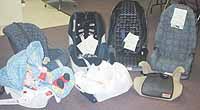Americans have made considerable progress during the last two decades in protecting children traveling by car, bicycle and school bus as well as when youngsters are pedestrians.
Carbon County parents who did not grow up using a child safety seat, a bike helmet and perhaps a seatbelt now understand that the protections can save youth’s lives.
As part of an ongoing education campaign, the National Highway Traffic Safety Administration strives to educate adults in the local community about the importance of safety seats, booster seats and/or seatbelts. NHTSA also reminds citizens of the importance of children wearing safety helmets while participating in sports and recreational activities.
Progress has been made in increasing the use of child safety and booster seats, which has decreased deaths among children in car and truck crashes, but much more remains to be done.
Motor vehicle crashes remain the leading cause of death for all children ages 6 to 15 years of age as well as for older teens and young adults.
In 1999, there were 550 motor vehicle occupant fatalities among children younger than 5 years old. More than half of the children who died were totally unrestrained.
In that same year, child safety seats or seatbelts saved the lives of an estimated 307 youngsters. NHTSA estimates that 162 more lives could have been saved if all motor vehicle occupants younger than 5 years old had been correctly restrained in child safety seats.
Children who are not restrained are three times more likely to be injured in a motor vehicle accident, stresses the highway traffic safety administration. Several basic guidelines to follow when securing children in a motor vehicle include:
•Youth 12 and younger should be buckled up in the back seat. The front seat is a more dangerous spot for children.
Front air bags deployed in even minor fender-benders have seriously hurt and even killed some children.
•When placing a child safety or booster seat in a car or truck, adults should read the instructions in order to install and use the devices correctly.
Motorists should also look at the vehicle’s owner’s manual to determine what it recommends about installing and using child safety seats and booster seats.
•Growing youngsters should progress through three types of child safety devices before using the seatbelt alone. The three types are rear-facing, forward-facing and booster seats.
•Infants should always be placed in rear-facing seats until the youngsters are at least 1 year old and weigh 20 pounds.
•Youth weighing between 20 and 40 pounds should be placed in forward-facing safety seats.
•When a child outgrows the forward-facing safety seat, motorists should use a booster seat until the youngsters is at least 8 years old or is four feet, nine inches tall.
Seatbelts alone are made for adults. A booster seat raises a child up so the safety belt fits.
The safety device prevents a child from being thrown from the car or bounced around inside the car or truck during a crash.
•Youngsters who have outgrown booster seats should use vehicle safety belts.
Child safety seats reduce fatal injury by 71 percent for infants and by 54 percent for toddlers ages 1 to 4 in passenger cars, indicates the highway safety administration.
For infants and toddlers riding in light trucks, the seats reduce fatal injury by 58 percent.
Safety seats may be installed and used in a motor vehicle, but at least four out of five children in are not properly restrained.
Safety seats may be inspected and proper use may be explained by a certified child passenger technician.
Southeastern Utah Health District may be contacted for instructions on proper use of safety seats.
NHTSA reminds residents that children injured in traffic crashes are not always passengers in vehicles.
More than one-fourth of bicyclists killed and 43 percent of youth injured in traffic accidents in 1999 were between the ages of 5 and 15.
During the same year, 580 pedestrians younger than 16 died and 27,000 were injured in traffic crashes.
Nearly one-fifth of all traffic fatalities and 7 percent of all injuries involved pedestrians younger than age 16.
On average, about three-fourths of all school-age children killed in bus-related traffic crashes are pedestrians.
The statistics serve as a grim reminder for all motorists to be cautious and aware of surroundings when driving, points out the NHTSA.
Bus signals should be obeyed and pedestrian crossing approached with caution to reduce the risk of minor traffic violations becoming major accidents, emphasizes the safety administration.
Bicyclists should always wear safety helmets. Whether the ride is around the block or miles long, helmets should be worn to prevent serious injury in the event a crash happens to occur.
Carbon citizens are urged to exercise caution and take steps in protecting not only children, but also adults while traveling, concludes NHTSA.
Highway administration stresses protecting child passengers

